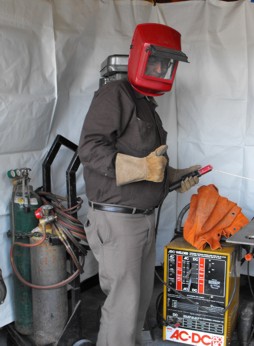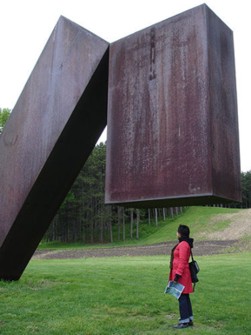Welding Safety Details
SOME IMPORTANT WELDING SAFETY DETAILS:
These are the areas that I will cover:
* Safe clothing
* Fire safety
* Use of arc welding equipment
* Torch safety
* Safe practices in general
* Equipment gone bad
* Arc "flashes", shocks, burns, "pinch points", and more
* General Welding Safety Items

Safe Clothing:
Above is how I normally dress for welding. If I'm doing overhead welding, I'll put on the leather jacket too. I ALWAYS wear long sleeves. I ALWAYS wear the helmet for welding or the goggles for torch work.
Wearing short sleeves will get you sunburned. Not wearing gloves can get your hands burned or sunburned. Yes I've tried it during real hot weather, & the sunburn is for REAL.
If you wear boots, don't tuck your pants inside! One of my welder helpers did & he soon went DANCING around due to the hot sparks. We both laughed about it later, but it wasn't funny at the time.
Got long hair? You better keep it back or cut it shorter. The guy mentioned above had fairly long hair at one time. Then he caught it on fire while doing torch work. Hair can burn REALLY fast. He came to work the next day with a lot shorter hair!
Doing some necessary work in wet conditions? Try to build a temporary shelter, or make sure you have on DRY gloves, etc. If conditions are wet enough, get some rubber WELDING gloves.
Protective clothing is a MAJOR part of Welding Safety!
Fire Safety:
I don't start welding until I have at LEAST a bucket of water nearby. It's good to also have a water hose & any pressurized fire fighting equipment if you have them.
Learn to know the SMELL of burning clothing & other items around the job. Have a "helper" around to watch for fires when possible. Learn to pay attention to unusual LIGHT flickering in your side vision. You may even HEAR a burning sound besides the arc sounds.
Sooner or later, something will catch fire. Catch it before it gets out of hand. People everywhere, everyday, weld by themselves. Don't unless you don't have a choice.
When it comes to Welding Safety, PREVENTION SAVES PAIN!
Arc welding safety with your equipment
1) Skin burns: Simple. Wear clothing wherever you don't want to get burned. The ARC is hot, & the metal you're working on is too. If you feel your leather glove getting hot, let go of the metal & remove the glove! It WILL get hotter.
Welding sparks can set your clothing on fire. It can be burning BEFORE you smell it. Keep checking yourself & your surroundings.
Metal you've just welded will STAY hot for awhile. Use your gloves to move it.
2) Ventilation: Open the garage door, turn on a fan, & keep "up-wind" of the fumes. Don't weld forever without taking breaks & getting to fresh air.
3) Shocks: Start your weld on the same side of the material where the ground clamp is. It will start easier & you won't become part of the electrical path. Use DRY GLOVES, & try not to work in wet areas.
If you MUST work in wet areas, you can use rubber WELDING gloves. They are very heavy duty. If you're stick welding (versus wire welding), you may get a jolt when you insert the rod into the holder with wet leather gloves.
4) "Flash burns": Even looking at the sun for a second or so can HURT. If you see the arc directly without protection for long, you will have the equivalent of sun-burned EYES! If you don't get it too bad, it will go away shortly.
If you get "flashed" very much it will hurt for a long time. I got it bad once & had to go to a doctor to get medicine to put in my eyes. I think it was called "pontocaine". It worked INSTANTLY, & what a relief!
Also, be kind to those around you & tell them to "watch their eyes". When I was still new to welding, they called me "Lightning" because I wasn't warning them before striking an arc.
You need to read these WELDING SAFETY DETAILS more than once!
MORE WELDING SAFETY DETAILS:
Torch safety
1) The cutting torch & related equipment can be dangerous. First, SECURE the tanks to a wall or build a cart for them & keep the chain across them. A fellow worker told me about the time he saw an oxygen tank fall & break the top valve assembly off. Then it went flying literally through the roof!
Remember, there's up to 2000 PSI in the O2 tanks. Again, keep the tanks secure. PLUS if you're replacing them, make sure the cap is on the full one.
2) Once you have a flame going, you will get an INSTANT BURN if you run that flame across your hand! After you make a cut, the metal will stay HOT for quite awhile. Use gloves to handle work in-progress.
3) Welders are really "Special Mechanics", & we all get greasy. You don't want grease catching fire. It's extra hard to get "out". Clean up wherever you can. A trick a mechanic friend of mine showed me, was to use margarine for my dirty hands. Use it just like you would waterless cleaners. It works really good.
Just take a teaspoon (or tablespoon) full, and work it till it's liquid, then rub it around the grime, then wipe it off with paper towels. (THEN go in the house & use regular soap to get the margarine off). Your wife will love you for not coming in totally greasy!
4) Keep all fittings tight. If the "gas" fittings are loose enough, it could catch fire AT that fitting.
5) Don't lay the acetylene tank flat for transport, because it could become explosive the next time you turn it on & light it up.
6) When opening the acetylene tank valve, just turn it 1/2 turn. It makes everything safer.
7) Use goggles to cut or weld. Yes there are those that don't, but I hope it won't be YOU!
8) Keep your goggle lenses clean. I use my leather gloves to do that, & leather works just fine.
9) If you're "setting the flame", & the "gas" separates from the tip, just back off the "gas" valve a bit.
10) If your hear a buzzing, sucking noise, immediately turn the "gas" valve off, then the O2. It may be backing up into the hoses & could be a bad thing.
11) Check the whole area before you cut. Clear out gas cans, etc. And look for items that might catch fire. Also, bring out the water buckets, water hoses, & other pressurized fire fighting equipment. And have someone nearby, if possible to be the "fire-watch".
12) "Crack open" the main tank valves before you hook them to hoses to make sure there's no contamination.
13) Don't tuck in your pant legs, or you'll be dancing & jumping around if enough sparks get inside the boots! I've seen a fellow welder doing exactly that.
14) Break out your steel-toed shoes if you're going to do any heavy cutting. One day I just happened to look down & noticed a DENT in my shoe toe. I didn't even know it happened until I SAW it.
15) If you're not sure about something, & I didn't cover it, ASK someone, or at least THINK FIRST.
The next time you start a welding project, think to yourself, " What have I told my buddy helping me about Welding Safety?"
Back to Welding Safety MAIN PAGEWELDING SAFETY DETAILS:
Equipment Gone Bad:
Note that some equipment failures can be just "a pain", but others might be a safety problem. Try to keep your equipment clean & working right:
1) If your arc welder overheats too much it could either be a "goner", or even cause it to start smoking internally. Pay attention to "duty cycle" especially if your machine has no cooling fan or a warning mechanism ( a warning light or an automatic breaker).
I was welding along at home & noticed that the rod was sticking a lot to the work-piece. And I noticed that it SOUNDED different suddenly. I soon realized that my cooling fan had died. I replaced it & it's been working fine for years now.
2) Can't see what you're doing very well? Check your lenses & clean them on both sides (use your leather glove).
3) The circuit breaker kicking off? Maybe you need to go to a bigger breaker. Plus you might have to use a smaller rod & make more "passes".
4) Is your helmet lens getting messed up from hot sparks? Add a protective cover lens (they are cheaper than your main lens).
5) Is the torch doing excessive splattering? You may be getting the tip too close to the puddle, or the cut. Or you might just need to use tip cleaners (or have both problems).
6) Is your torch not cutting very well? If you have the smaller (& cheaper) single stage gauges, you might try cranking up the cutting pressure again. This was going on for my single stage outfit, & I just assumed I was real low on acetylene.
When I shut off the tanks later, I saw that the O2 cutting pressure reading was still at 20 PSI. So I was only using 20 PSI to cut instead of 40! I pulled the gauge's needle off & re-set it. It was good to go again.
Welding Safety includes safe equipment and safe usage!
GENERAL WELDING SAFETY ITEMS:
> When handling heavy equipment like auto engines, it's much safer to use a chain hoist instead of a come-along. Come-a-longs can lose the load if you're not super careful.
>Welding Safety MEANS safety for you AND your customer AND those helping you!!
> Have a GOOD look at the photo below. Do you trust your weld?? Once you can "run" decent weld beads, Take Pride in the Work You Do! Make sure you do as best you can so that no one gets hurt.

Photo by ebmorse at flickr.com
Back to Welding Safety MAIN PAGE
Want to learn more about ALL WELDING subjects? Learn from my ebook, "The Arc And Beyond"!
